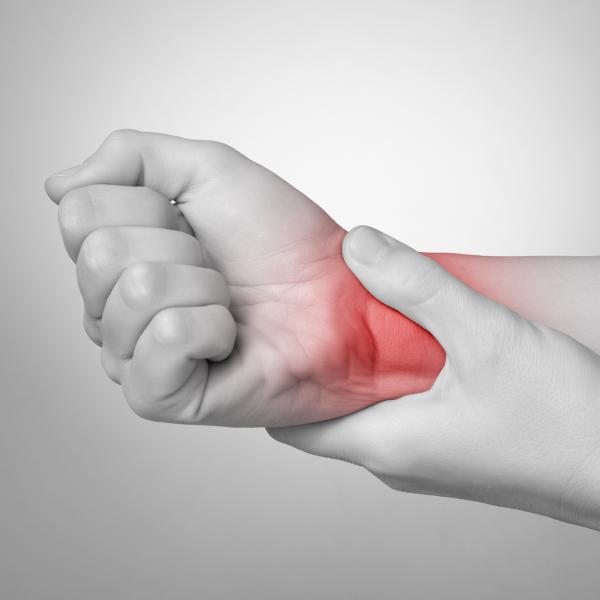
By Kristy Loose, DPT, OTR/L, CHT, Angela Bender and Cori Cameron
As stated by Mary Reilly, “Man through the use of his hands as they are energized by mind and will, can influence the state of his own health.” The wrist is a crucial joint for our hands to be able to explore our environment and injuries can lead to serious functional impairments.
The wrist joint is comprised of three main joints: radiocarpal, midcarpal, and intercarpal joints. The main motion at the wrist joint is flexion/extension (movement of the wrist up and down) and radial deviation/ulnar deviation (movement of the wrist from side to side) which are accomplished via five primary movers and three peripheral nerves. Being aware of common conditions and causes of pain, how to treat them, and how to generally keep our wrists healthy, can be a key factor in preventing an acute injury from progressing to chronic, life-long pain.
Common Causes
While we may not think about how much use our wrist typically gets in a day, when we start to experience pain we definitely take notice of the importance of this joint. Injuries, arthritis, and other ailments can all cause pain.
- Carpal Tunnel Syndrome – CTS is caused when the median nerve becomes compressed, or pinched. This compression is caused by swelling in the wrist; the wrist pain associated with this is due to the excess pressure on the nerve.
Sudden (Acute) Injuries – Sprains, broken bones, and tendonitis can all cause pain in the wrist. Symptoms of an injury can include swelling, bruising, or disfigured joints near the wrist.
Arthritis – Pain, stiffness, and swelling of the wrist may be caused by various forms of arthritis. Arthritis can be caused by many things, including overuse, aging, and normal wear and tear.
Gout – When your body breaks down foods containing purines, uric acid is produced. A buildup of uric acid may cause gout, which can result in pain and swelling in the wrists, knees, ankles and feet.
Common Conditions
While there are multiple conditions associated with wrist pain, some of the common conditions include:
- Carpal Tunnel Syndrome – CTS is a condition that causes numbness and tingling in the hand and arm. The syndrome is caused by a compressed nerve in the carpal tunnel, the narrow passageway on the palm side of your wrist.
Strains – A wrist strain can occur when there is a simple overstretching of the tendon or the ligaments of the wrist bone, or it can occur when there is a partial or complete tear in the tendon or the ligaments.
Sprains – A sprained wrist is an injury to any of the numerous ligaments which connect bone to bone in the wrist.
Tendonitis – Tendonitis is an irritation and inflammation of one or more of the many tendons surrounding the wrist joint.
Arthritis – Inflammation in any of the small joints in the wrist can be a sign of arthritis. Arthritis attacks your bones by destroying the cartilage, causing your bones to rub against one another.
Injury Prevention
Kristy Loose, DPT, OTR/L, CHT, gives us some tips to help prevent and rehabilitate wrist injuries:
- Watch Your Positioning – Keep your wrists straight or only slightly bent while performing activities. Avoid activities that bend or twist the wrists for long periods of time.
- Take Breaks – Take frequent breaks from typing or other repetitive activities to stretch your hands and wrists.
- Watch Your Grip – Whenever possible, use your whole hand to grasp an object. There may be less pain with gripping in a supinated (palms-up) position rather than a pronated (palms-down) position.
- Wear the Right Protective Equipment during Activities – When working with tools that vibrate (drills, sanders), use specially designed gloves that support the wrist and have vibration-absorbing padding. Take frequent breaks, and switch hands often.
- Pay Attention – Stop any activities that you think may be causing numbness and pain.
Rehabilitation
If you have pain in your wrist that isn't going away, rehabilitation can help to improve functionality. During rehabilitation you will work on:
Avoiding Gripping – Gripping increases carpal load.
Considering Forearm Position to Minimize Carpal Load and Create a More Stable Wrist – In a neutral wrist position, 80% of the load is transmitted through the radiocarpal joint and 20% through the ulnocarpal joint. Pronation and ulnar deviation may increase ulnocarpal load up to nearly 40%, something to keep in mind when choosing your positioning for therapy exercises in those with ulnar sided wrist pain.
Maximizing Range of Motion Is Not the Goal – The goal is for functional range of motion with good stability and no pain.
Gradual Strengthening – Using isometrics, eccentrics, and concentrics.
Stabilization – Extensor carpi ulnaris, flexor carpi ulnaris, and hypothenar muscles will stabilize the ulnar wrist, while flexor carpi radialis will stabilize the radial wrist.
When weighing your treatment options for wrist pain and injuries, consider occupational therapy. ATI Physical Therapy offers a wide variety of treatment options including strengthening, stretching, and sustainable home exercise programs. Stop in or call any ATI location for a complimentary injury screen or to learn more about how we can help you overcome your elbow pain.
It’s all in the wrist!
